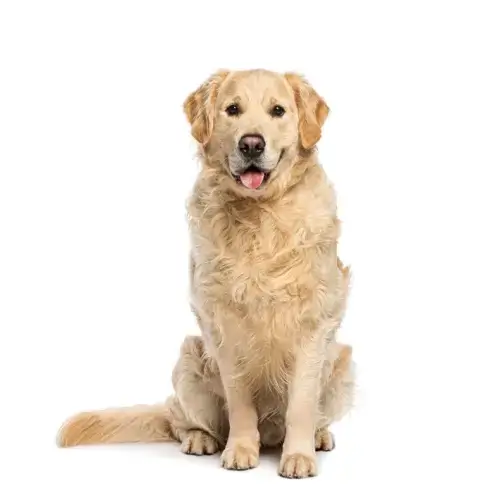Home / Compare Pet Insurance / Large dog breeds in Aust…

Key takeaways
- Large dog breeds are popular in Australia for their loyalty, protective nature and ability to provide a sense of security due to their size. They also make great companions for active families.
- In Australia, dogs weighing 26kg to 44kg are considered large, while those weighing above that are labelled giant breeds requiring special diets for bone, joint and digestive health, as well as more exercise.
- Before getting a large dog, it’s essential to consider factors like space requirements, time commitment for exercise and training, higher costs for food and veterinary care, and the breed’s temperament to ensure a good fit for your family and lifestyle.
What is considered a large dog in Australia
Large dogs are typically defined by their size and weight; in Australia, a dog is considered large if it weighs between 26 kilograms and 44 kilograms.2 These breeds include Labradors, Golden Retrievers and Rottweilers.
Any dog weighing 45kg or more are classed as giant breeds.2 Giant breeds, like the Great Dane, Newfoundlands and Saint Bernard, can weigh over 60kg, showcasing their impressive stature.
Large and giant dog breeds require specially formulated foods to promote bone, joint and digestive health, as large dog breeds may have slower metabolism and higher exercise requirements.
What are the large dog breeds in Australia?
Large dog breeds are popular in Australian homes and noted for being good watchdogs, their devotion, protective temperament and strong friendship. Labrador Retrievers, German Shepherds, Golden Retrievers, Great Danes, Newfoundlands and Irish Wolfhounds are among popular breeds.1 While these different breeds of dogs have different temperaments and physical requirements, they’re also well known for their adaptability and family-friendliness.
Which large dog breeds are the most suitable for families?
Large dog breeds can make excellent companions as family dogs due to their gentle nature, patience and protective instincts. In Australia, several large breeds are particularly suitable for families or first-time dog owners. These breeds share qualities that make them suitable for families, including gentleness, protective instincts, sociability and adaptability.
Golden Retriever
 Golden Retrievers are renowned for their friendly, calm and gentle temperament.7 They are patient and tolerant, making them ideal for households with young children. Golden Retrievers are also highly trainable and enjoy playing, making them great companions for active kids or to be trained as therapy dogs. Their even-tempered nature ensures they adapt well to different family dynamics.
Golden Retrievers are renowned for their friendly, calm and gentle temperament.7 They are patient and tolerant, making them ideal for households with young children. Golden Retrievers are also highly trainable and enjoy playing, making them great companions for active kids or to be trained as therapy dogs. Their even-tempered nature ensures they adapt well to different family dynamics.
Labrador Retriever
 Labradors are one of Australia’s most popular dog breeds, loved for their playful, affectionate and loyal personality.8 They are particularly good with children due to their sociable and tolerant nature. Labradors thrive on companionship, and their high energy makes them perfect for an active family, allowing them to join in on all types of activities, from playing in the yard to going on adventures together.
Labradors are one of Australia’s most popular dog breeds, loved for their playful, affectionate and loyal personality.8 They are particularly good with children due to their sociable and tolerant nature. Labradors thrive on companionship, and their high energy makes them perfect for an active family, allowing them to join in on all types of activities, from playing in the yard to going on adventures together.
Newfoundland
 Often called ‘nanny dogs’, Newfoundlands are famous for their gentle and protective nature around children.9 They’re incredibly patient and calm, making them excellent companions for families with toddlers. Despite their large size, Newfoundlands are affectionate and soft-hearted, forming strong bonds with their families. They also love water, so they’re perfect for families who enjoy outdoor water activities.
Often called ‘nanny dogs’, Newfoundlands are famous for their gentle and protective nature around children.9 They’re incredibly patient and calm, making them excellent companions for families with toddlers. Despite their large size, Newfoundlands are affectionate and soft-hearted, forming strong bonds with their families. They also love water, so they’re perfect for families who enjoy outdoor water activities.
Bernese Mountain Dog
 The Bernese Mountain Dog is a calm and friendly breed, well-suited to families with children.10 They are affectionate and gentle, with a playful side that makes them great with young kids. Known for their loyalty, Bernese Mountain Dogs are protective without being aggressive, ensuring a safe and loving environment for children.
The Bernese Mountain Dog is a calm and friendly breed, well-suited to families with children.10 They are affectionate and gentle, with a playful side that makes them great with young kids. Known for their loyalty, Bernese Mountain Dogs are protective without being aggressive, ensuring a safe and loving environment for children.
Great Dane
 Despite their towering size, Great Danes are gentle giants with a surprisingly affectionate nature.4 They are known for being patient and tolerant, making them good companions for children. While they may require supervision due to their size, Great Danes are calm and loving, making them excellent family pets for households with enough space.
Despite their towering size, Great Danes are gentle giants with a surprisingly affectionate nature.4 They are known for being patient and tolerant, making them good companions for children. While they may require supervision due to their size, Great Danes are calm and loving, making them excellent family pets for households with enough space.
Poodles or Poodle crosses
 Poodles and Poodle crosses (like Labradoodles, Cavoodles and Groodles) are excellent family dogs due to their intelligence, trainability and affectionate nature.11 This intelligent dog breed bonds well with children, is adaptable to various living environments and thrives in active households. Their hypoallergenic, low-shedding coats suit families with allergies, although regular grooming is needed. These dogs are playful yet gentle, making them great companions for kids, while their versatility and loyalty ensure they fit seamlessly into family life.
Poodles and Poodle crosses (like Labradoodles, Cavoodles and Groodles) are excellent family dogs due to their intelligence, trainability and affectionate nature.11 This intelligent dog breed bonds well with children, is adaptable to various living environments and thrives in active households. Their hypoallergenic, low-shedding coats suit families with allergies, although regular grooming is needed. These dogs are playful yet gentle, making them great companions for kids, while their versatility and loyalty ensure they fit seamlessly into family life.
Australian Shepherd (Aussies)
 Australian Shepherds are known for their unmatched loyalty, intelligence and versatility, making them great guard dogs.12 These traits make them one of the most sought-after working dog breeds, often used in police, military and search-and-rescue roles. While protective and alert, Australian Shepherds are affectionate with their families and can form strong bonds with children when appropriately socialised. Their confidence and eagerness to learn make them a rewarding breed for experienced dog owners.
Australian Shepherds are known for their unmatched loyalty, intelligence and versatility, making them great guard dogs.12 These traits make them one of the most sought-after working dog breeds, often used in police, military and search-and-rescue roles. While protective and alert, Australian Shepherds are affectionate with their families and can form strong bonds with children when appropriately socialised. Their confidence and eagerness to learn make them a rewarding breed for experienced dog owners.
What should I consider before getting a large dog breed?
 Large dog breeds come with unique challenges and rewards. Before bringing a furry friend home, checking whether you can meet their needs is important. Always research the dog breed and the care requirements of that breed before making a lifelong commitment to your new buddy. Here are the most important factors to consider:
Large dog breeds come with unique challenges and rewards. Before bringing a furry friend home, checking whether you can meet their needs is important. Always research the dog breed and the care requirements of that breed before making a lifelong commitment to your new buddy. Here are the most important factors to consider:
- Space requirements: Large dogs need room to move and stretch. While some breeds, like Great Danes, can adapt to apartment living, most large dogs thrive in homes with a backyard or access to open spaces. Crowded environments may lead to stress or destructive behaviour.
- Time commitment: Large breeds often require significant time for exercise as many large dogs are active and need daily walks, runs or playtime to stay physically and mentally healthy. They also need consistent training to ensure good behaviour, especially since their size can make untrained habits problematic.
- Costs: Owning a large dog is often more expensive. For instance, larger dogs consume more food, which increases monthly expenses. Veterinary care can also be more expensive when you own a large dog as they are more prone to certain health issues, such as hip dysplasia and joint problems, which can be costly to treat.
- Lifespan: Large dogs typically have shorter lifespans than smaller breeds. Prospective owners should be prepared for the emotional and financial commitment of caring for dogs with potential health challenges as they age.
- Strength and handling: Many large breeds are physically strong, requiring an owner who can handle their strength during walks or training. Proper leash manners and obedience training are crucial.
- Family and lifestyle fit: Consider whether the breed’s temperament suits your family’s lifestyle, including whether the breed is good with children, whether their energy level matches your activity preferences and if they’re comfortable with other pets and visitors.
More information
Biggest dog breeds
- The Irish Wolfhound is known as the tallest dog breed, with some dogs of this breed reaching up to 100 cm tall.3 Despite its towering appearance, Wolfhounds have a soft, gentle and affectionate personality. These calm, intelligent and friendly dogs make wonderful family pets; however, they retain a hunting instinct from their history as hunting dogs in Ireland, so proper training and supervision are crucial. Irish Wolfhounds are sensitive and form deep bonds with their families despite their size.
- Often referred to as ‘gentle giants’, Great Danes are known for their imposing size but equally for their affectionate and gentle nature.4 Despite their massive stature, they are incredibly friendly, patient and calm, especially around children. Great Danes are also surprisingly adaptable to indoor living, provided they have enough space to stretch out. Their affectionate and low-energy nature makes them excellent companions, though their short lifespan can be a consideration for potential owners.
- A muscular, large breed weighing up to 120kg, Saint Bernard’s are known as working dogs in the Swiss Alps, but their loving and patient temperament makes them equally suited to family life.5 These gentle giants are affectionate and protective, often forming strong bonds with children. They are laid-back when indoors but require regular exercise to maintain their health. Their thick double coats, while beautiful, make them less suited to hot climates.
Why choose a large dog breed?
Dog owners often choose large dogs for loyalty, protection and emotional support. Their size gives a sense of security compared to small dog breeds, and many large dogs are known for their calm and affectionate demeanour, making them excellent companions. They’re especially favoured by families who have ample space and enjoy an active lifestyle, as many large breeds thrive with regular exercise and outdoor activities.
Whether you’re seeking a loyal guardian, the smartest companion or a gentle family member, there’s a breed to suit every lifestyle. These majestic animals can enrich your life in countless ways with proper care, training, and love.
What are the most popular large dog breeds in Australia?
Large dog breeds are not only defined by their size but also by their unique personalities, temperaments and traits.
Labradors and Golden Retrievers are among Australia’s most popular large breeds due to their intelligence, trainability and loving nature.6 German Shepherds are another favourite, valued for their versatility and loyalty. Other beloved breeds include Great Danes, Saint Bernard’s and Newfoundlands, each bringing their unique qualities to the table.1
It’s always important to remember that while these breeds are popular, they must be trained early to ensure they’re well-mannered and responsive. Always supervise the interactions between your dog and your children (especially if they’re very young) and build your dog’s confidence by introducing them to different environments, people and experiences to socialise with them early.
Pet insurance for large dogs
Purchasing pet insurance for your beloved dog can help safeguard against the potential financial burden of an accident or illness. Large dogs may incur higher medical bills due to their size, particularly as they age. Pet insurance can help cover some vet bills, enabling you to focus on keeping your pet healthy again.
It’s a good idea to insure your pet early in life or before they show symptoms of these problems, as pre-existing conditions may not be covered by pet insurance. Read your Product Disclosure Statement (PDS) for complete details.
Meet the pet insurance expert, Adrian Taylor
As a General Insurance expert with over 13 years’ experience in financial services, Adrian Taylor knows that dogs and cats get themselves into all sorts of mischief. One part of Adrian’s work is to help empower consumers to understand how pet insurance can help save them from exorbitant vet bills when their pet gets injured or falls ill.
Want to know more about pet insurance?
1Assistance Dogs Australia. ‘5 Big Dog Breeds We Love’. Accessed November 2024.
2Petbarn. ‘How do I tell what breed size my dog is?’ Accessed November 2024.
3American Kennel Club. Irish Wolfhound Breed Traits and Characteristics. Accessed November 2025.
4American Kennel Club. Great Dane Breed Traits and Characteristics. Accessed November 2025.
5American Kennel Club. Saint Bernard Breed Traits and Characteristics. Accessed November 2025.
6Petstock. ‘Top 20 Family Dogs Australia’. Updated July 2024
7American Kennel Club. Golden Retriever Breed Traits and Characteristics. Accessed November 2025.
8American Kennel Club. Labrador Retriever Breed Traits and Characteristics. Accessed November 2025.
9American Kennel Club. Newfoundlands Breed Traits and Characteristics. Accessed November 2025.
10American Kennel Club. Bernese Mountain Dog Breed Traits and Characteristics. Accessed November 2025.
11Coops and Cages. Poodles Cross Breeds. Accessed November 2025.
12American Kennel Club. Australian Shepherd Breed Traits and Characteristics. Accessed November 2025.



